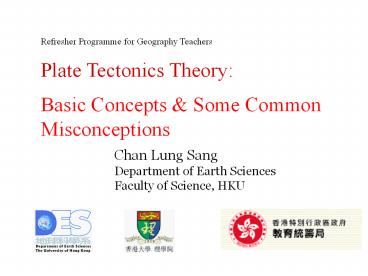Pr - PowerPoint PPT Presentation
1 / 36
Title: Pr
1
Refresher Programme for Geography Teachers
Plate Tectonics Theory Basic Concepts Some
Common Misconceptions
Chan Lung Sang Department of Earth
Sciences Faculty of Science, HKU
2
?? (??,????????,????????) ?? (??,???) ?? (????,?
????????,????)
Landform and Endogenetic Processes
3
Part 1 Plate Tectonics
- History of Development
- Basic Concepts
- Earths interior model
- Crustal provinces structures
- Rock formation
- Energy sources
- Mineral and oil formation
- Tectonics and Geology of Hong Kong Region
- MANY OF THE FIGURES USED IN THIS
PRESENTATION WERE DOWNLOADED FROM THE INTERNET.
THEIR CREATORS , OFTEN ANONYMOUS, ARE GRATEFULLY
ACKNOWLEDGED
4
1. From Continental Drift to Plate Tectonics
5
Alfred Wegener
- Paleoclimate
- Fossil evidence
- Geological evidence
- Coastline geometry
6
Birth of the Plate Tectonics Theory
- Plate tectonics theory was founded upon the
following new findings in the late 1960s - Ocean floor topography
- Marine magnetic anomalies
- Paleomagnetism geomagnetic field reversals
- Sea floor spreading
7
Plate Boundaries, Earthquakes and Major Volcanoes
of the World
8
Note new designation of plate boundary at Japan.
9
Plate Boundaries
Note associated landforms axial rift at
mid-ocean ridge, sea trench at subduction zone,
sea mounts and island arc.
10
A paradigm shift - A unifying theory accounting
for
- Earths interior structure
- Origin of atmosphere hydosphere
- Crustal structures and provinces
- Volcanism earthquakes
- Rock record
- Fossil record
- Sedimentary basins
- Petroleum and mineral formation
- Geophysical fields
11
2. Earths Interior Structure
12
Studying Earths Interior
Earth scientists use the following techniques to
determine Earths interior structure
- Earthquake waves
- Whole-earth free oscillation
- Rock records
- Meteorite compositions
- Geomagnetism
- Heat flow geothermal gradient
- Lab experimentation
- Numerical modeling
13
Earths Abundance
- Four major elements O, Fe, Si, Mg 85
- Only 3 S
- Earths crust depleted in siderophile (Fe, Ni, Cu
etc.) but enriched in K and Al - Mantle - Mg silicate
- Core FeS, FeO and Fe
14
Earths Interior Model
Mantle is not liquid convection occurs due to
material rheology.
Shell Name Name Depth (km) Composition State
A Crust Crust 0-30 Al-rich silicate solid
B Noncrustal Lithosphere Upper Mantle 30-100 Mg-rich silicate (olivine) solid
C Asthenosphere Upper Mantle 100-640 Mg-rich silicate (olivine) near melting
D Lower Mantle Lower Mantle 640-2800 Mg-rich silicate (olivine) solid
D Mantle-Core Transition Mantle-Core Transition 2800-2890 Mg-rich silicate (olivine) soild (softer)
E Outer Core Outer Core 2890-4600 FeSFe liquid
F OC-IC Transition OC-IC Transition 4600-5160 FeFeO liquidsolid
G Inner Core Inner Core 5160-6370 FeFeO solid
15
Earlier idea on crustal structure
The concepts of sial and sima are old and
imprecisely describe current understanding of
crustal structure.
16
Lithosphere includes the crust and part of the
upper mantle. Asthenosphere is not a molten
layer. Note deepening of Moho beneath mountains
due to isostasy. The distinction between
lithosphere and asthenosphere is by means of
physical strength, not composition
17
3. Crustal Provinces Structures
Crustal provinces and structures at different
scales are results of tectonic evolution and
associated stress system
18
Growth of North America Continent
19
?????????
??????????
?????????????
20
Most folded mountain belts are continental suture
zones
21
Structures on smaller scale
Tension gashes
Overturned syncline
Plunging S-fold
Graben structure
22
4. Rock Formations
23
Rock Cycle in Plate Tectonics Context
24
Igneous Metamorphic Rocks
Most magmas form from melting of mantle and
crustal material in the overriding plate and not
the descending plate.
25
Ophiolite suite of oceanic crust and mantle
rocks
Pillow basalt intruded by mafic dikes, Cyprus
26
The Obsolete Concept of Geosyncline
What formerly called geosynclines are now known
to be mountains that formed in active continental
margins The term should not be used anymore.
27
5. The Energy Source
28
Earths Source of Energy
- Primordial heat
- Radioactivity
- Gravitational heat
- Phase changes
29
Outer Core-Inner Core Relation
Phase change, not radioactivity, is the primary
energy source for plate motion.
Outer core condenses gradually to become part of
inner core. The process probably involves also a
compositional change.
30
Mantle Convection heat energy from core
???? ??????
Not all spreading ridges are located above
mantle divergence.
31
6. Mineral and oil Formations
32
ACTIVE VS PASSIVE MARGIN
- ACTIVE
- MARGIN
- magmatic activity
- mountain belt with thick continental crust
- narrow continental shelf
- active seismicity
- mineral deposit
- PASSIVE
- MARGIN
- Stable
- Wide continental shelf
- Continental crust thins out gradually
- Oil and gas resources
33
7. Tectonic Evolution of Hong Kong Region
34
Geological Map of Hong Kong (Geological Survey,
GEO)
35
End of Part 1 chanls_at_hku.hk Department of Earth
Sciences, University of Hong Kong
36
Useful Web Links
pubs.usgs.gov/publications/text/dynamic.html geol
ogy.er.usgs.gov/eastern/tectonic.html www.school.
discovery.com www.geolsoc.com.hk































